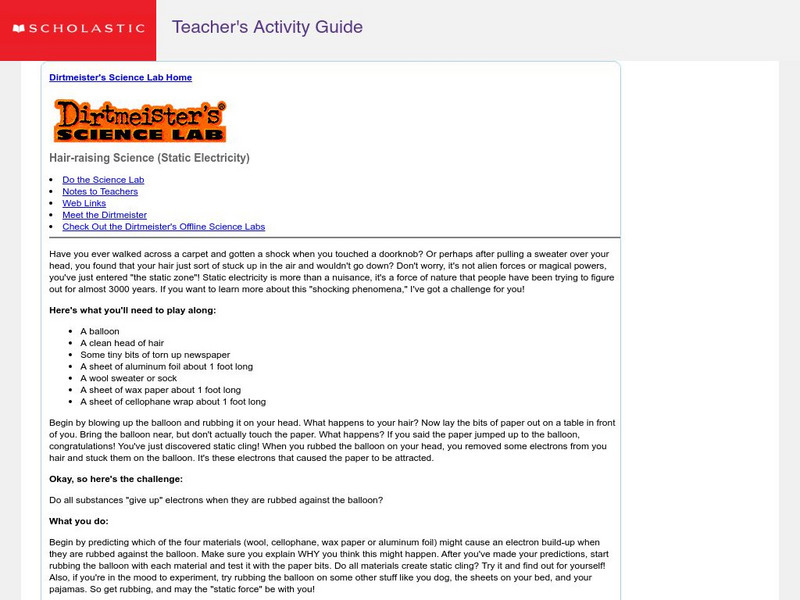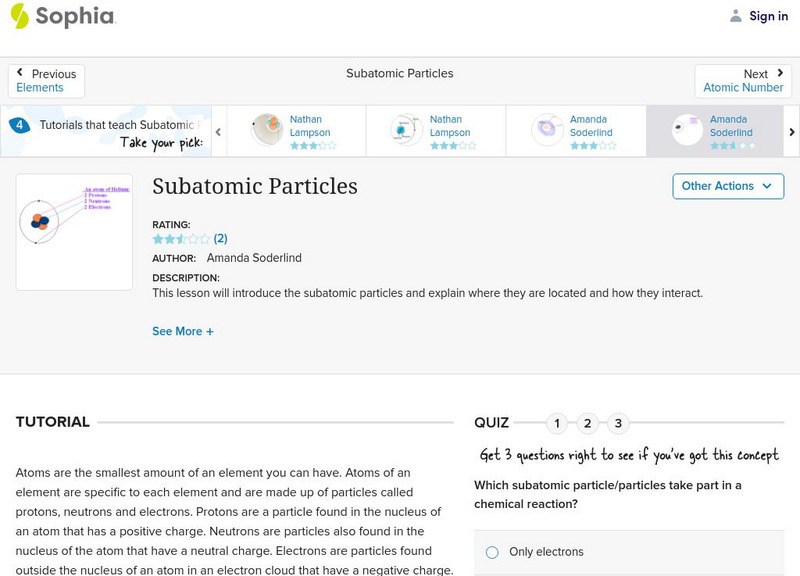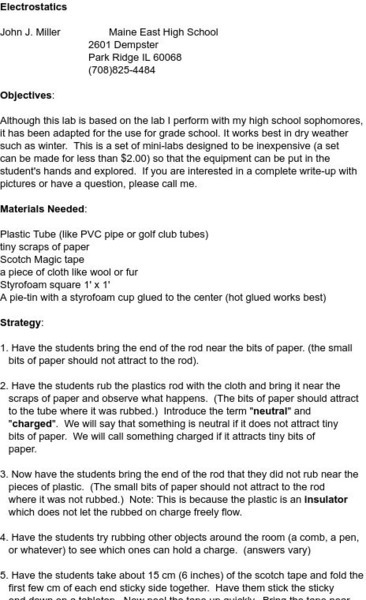Hi, what do you want to do?
Curated OER
Applied Science - Physics Lab
Students explore electricity. In this Physics lesson, students investigate the origin of static electricity. Students compare static electricity to current electricity.
Curated OER
Electric Charge
Students discover and identify positive and negative electrical charges and understand that like repels and opposite charges attract. In this physics lesson, students observe how friction can be used to give electrical charge to...
Curated OER
Positive and Negative Charge Using Balloons
Fourth graders observe and explain how balloons rubbed on a shirt create positive and negative charges. In this positive and negative charge lesson plan, 4th graders record their results and explain their findings.
Curated OER
Pith Ball Electroscope Lab
In this pith ball electroscope worksheet, students complete an experiment using a pith ball electroscope to determine charges. Students write down their observations and then complete 5 short answer questions.
Curated OER
What is an Electric Current?
In this electric current worksheet, students will write down three facts about electric currents. Based on these facts, students will come up with a conclusion as to what an electric current is.
Curated OER
Electricity Review
In this science worksheet, students locate thirty-eight vocabulary words and inventors related to electricity in a word search. answers are provided in various formats.
University of Kentucky
Elecroscope Lab
This site is actually a lab from the University of Kentucky Electrical Engineering Department. It is an excellent experiment that can be done at the high school level.
NOAA
Noaa: National Weather Service: Jet Stream Online School for Weather: Lightning
The National Weather Service presents this comprehensive site on lightning. Learn how lightning is created, what makes the sound of thunder, and ways to be safe during a storm. Learning lessons, frequently asked questions, and review...
PBS
Pbs Learning Media: Testing for Static Electricity
In this video segment adapted from ZOOM, cast members show you how to make your very own electroscope. You can use it to find out if an object is electrically charged. [4:17]
American Chemical Society
Middle School Chemistry: Protons, Neutrons, and Electrons
Investigate why a charged object is attracted or repelled by another charged object. Explore the concept that the attraction between positive protons and negative electrons holds an atom together.
Scholastic
Scholastic: Dirtmeister's Science Lab: Hair Raising Science
A great experiment to show students how electrons move by static electricity. This site includes web links, a challenge question, and notes for the teacher.
PBS
Pbs Kids Go!: Dragonfly Tv: Nanobots
Lead the Nanobot through an obstacle course. Remember how positive and negative charges work. Once players get the hang of the game try a creating an original course.
Science Bob Pflugfelder
Science Bob: Bend Water With Static Electricity!
Contains a procedure for illustrating electrostatic attraction between opposite charges by causing a thin stream of water to bend. The site gives a brief discussion of static electricity, as well.
Other
K 3 Learning Pages: Web Resources Thunderstorms
Check out this comprehensive list of web resources on thunderstorms and safety. Students and teachers will benefit from the links found on this site.
CK-12 Foundation
Ck 12: Physics Simulation: Electric Fields Simulation
[Free Registration/Login Required] In this simulation, students look at the question of whether one can score a goal in an electric field. They experiment with positive and negative charges to try to score goals.
Teachers TryScience
Teachers Try Science: Say Cheese
Follow these steps to create the chemical reaction required to make cheese. Good explanations and suggestions of ways to modify the experiment. Hands-on science.
Concord Consortium
The Concord Consortium: How Do I Know if Something Is Positively or Negatively Charged?
In this learning module from The Concord Consortium, students will learn how to figure out whether an object has a positive or negative charge.
University of Houston
University of Houston: Engines of Our Ingenuity: Franklin's Electricity
Some research puts Franklin's electrical work in the scientific and political context of his day. An interesting point of view, one not usually found in comments of Franklin and electrostatics. Done by a professor from University of...
Other
Museum of Science: Simple Electroscope
Resource explains how to build and use a simple electroscope.
Sophia Learning
Sophia: Subatomic Particles: Lesson 3
This lesson will introduce the subatomic particles and explain where they are located and how they interact. It is 3 of 7 in the series titled "Subatomic Particles."
Sophia Learning
Sophia: Subatomic Particles: Lesson 4
This lesson will introduce the subatomic particles and explain where they are located and how they interact. It is 4 of 7 in the series titled "Subatomic Particles."
Sophia Learning
Sophia: Subatomic Particles: Lesson 6
This lesson will introduce the subatomic particles and explain where they are located and how they interact. It is 6 of 7 in the series titled "Subatomic Particles."
Sophia Learning
Sophia: Subatomic Particles: Lesson 7
This lesson will introduce the subatomic particles and explain where they are located and how they interact. It is 7 of 7 in the series titled "Subatomic Particles."
Science and Mathematics Initiative for Learning Enhancement (SMILE)
Smile: Electrostatic Models
A teacher lesson plan which includes several hands-on activities pertaining to static charge, charge interactions, and the induction process. Students use readily available materials to investigate these concepts. Designed for pre-high...






















